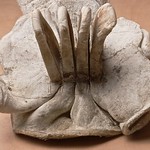The blog post on irregular tefilin mentioned flaws that are not apparent to the naked eye, and have no impact on the halachic status of the tefilin, but may still affect the retail price of the tefilin.
Besides those irregularities, there are others – often found in high quality batim – which may seem to be imperfections, but in reality are the result of hidurim adhered to in the process of making the tefilin.
note: Not all tefilin with the following qualities are necessarily mehudar, and it is possible to have mehudar tefilin that don’t exhibit any of these attributes.
 Batim are made by folding and stretching a flat piece of leather into shape. In particular, creating the shel rosh involves a great deal of manipulation to get the final form. Due to all this manipulation, there are often small cracks in the edges of the titura (the base of the tefilin).
Batim are made by folding and stretching a flat piece of leather into shape. In particular, creating the shel rosh involves a great deal of manipulation to get the final form. Due to all this manipulation, there are often small cracks in the edges of the titura (the base of the tefilin).
An even more common issue, which affects the shel yad as well as the shel rosh, is a horizontal crack around the titura. This is usually the seam where the upper and lower titura meet.
One way to hide these imperfections in the bayis is to cover them with many thick coats of paint. Another way is to use glue to fill in the cracks and “build up” the surface of the tefilin. Both these methods have halachic downsides and are best avoided if possible.
Ideally, the batim should be covered with a thin coat of paint, and glue should be used sparingly (or not at all). Noticeable cracks in the titura might not develop right away, but over time – sometimes a very short period of time – these cracks may become visible. halachically, as long as the titura doesn’t change shape to the point where it is no longer square, the kosher status of the tefilin is not affected.
-= 8 =-

